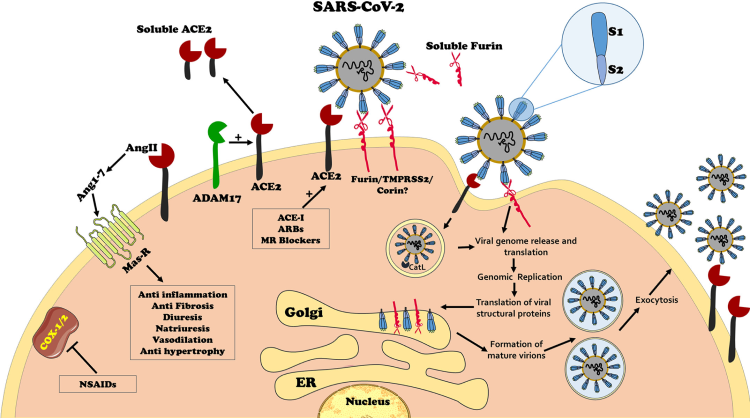A new study further elucidates the role of spike proteins in COVID-19.
Authors: Steven Novella May 5, 2021
A recent study looks at the effects of the SARS-CoV-2 spike proteins, showing that they can cause some of the harm of COVID-19 by themselves. This is an important advance in our understanding of the disease and hopefully will lead to new therapeutic interventions.
The spike protein is what gives the coronavirus family of viruses their name. The spikes jut out from the surface of the spherical virus, giving it a crown-like halo, hence “corona”. We have also known for a long time that the spike protein is the business end of these viruses, it is what gives the virus its ability to target, latch onto, and enter the cells that it infects. Mutations in the spike protein are also what determine different variants of SARS-CoV-2, and can alter its ability to infect and cause harm.
The new study, however, is the first to directly show that the spike proteins themselves are able to cause harm, and also confirms that COVID-19 is primarily a vascular disease that damages blood vessel walls.
What the researchers did was create a pseudovirus – a protein shell with spike proteins but no viral RNA inside. Therefore these pseudoviruses are unable to actually infect cells or replicate. The point was to isolate as much as possible the effects of the spike proteins themselves. They report:
We administered a pseudovirus expressing S protein (Pseu-Spike) to Syrian hamsters intratracheally. Lung damage was apparent in animals receiving Pseu-Spike, revealed by thickening of the alveolar septa and increased infiltration of mononuclear cells.
They had control animals with a mock virus that did not show this damage. The spike protein binds to the ACE2 receptor on cells, downregulates their function, and causes damage to the endothelium cells that line lung tissue and blood vessels. The damage is apparently caused by effects on the mitochondria (energy producing organelles) in the cells – they change their shape and have reduced function. They then reproduced these effects in vitro using a culture of lung endothelial cells exposed to the spike protein.
These results explain many of the clinical features of COVD-19. While the disease has been largely thought of as a respiratory illness, it is primarily a vascular disease. It affects the lungs, but also affects other organs in the body, and can cause strokes and blood clots. While the vascular effects of coronaviruses have long been known, this study demonstrates a clear mechanism of this injury. Knowing the precise mechanism may lead to treatments to prevent or limit the vascular damage from infection. The next step is to study exactly how downregulating the ACE2 receptor damages the mitochondria.
This study, of course, did not come out of the blue but was built on previous studies showing many of the same findings. It was known, for example, that the ACE2 receptor is important for coronavirus infection, and that it related to endothelium damage. In fact a comment to the FDA by Dr. Whelan nicely summarizes a lot of this research as of December 2020. This research, however, has raised some questions about the safety of the mRNA vaccines that produce spike proteins. To be clear, the safety data on the Pfizer and Moderna mRNA vaccines are now extensive, with hundreds of millions of doses give and months of data, without any significant side effects apparent.
The Pfizer and Moderna vaccines produce the full-length spike protein. Pfizer studied several formulations initially, but found that the full length protein vaccine had fewer side effects and was better tolerated than other vaccine candidates, so that is the one they went with. It is also likely that the full protein contains more epitopes (sites for immune activity) and therefore produces more thorough and longer lasting immunity. The proteins, however, are in a fixed state, they are unable to change their confirmation, which is necessary to bind to cells. So they function differently than spike proteins on infecting virus.
After the Pfizer vaccine full spike proteins are expressed on the vaccinated cells for presentation to the immune system. But the vaccine-induced proteins do not appear to cause any harmful effects. This may be because the vaccine is administered in the muscle, and so muscle cells are the ones taking up the mRNA and making spike proteins. There is a vigorous immune response which neutralizes the spike proteins before they can cause any harm. This is very different from a virus replicating throughout the body.
Unfortunately, the complexity of COVID, mRNA, immunity, and vaccines is such that those who wish to raise fears about the vaccine can exploit partial information. There is a tremendous amount of misinformation about the COVID vaccines, and the mRNA vaccines in particularly, which then has to be constantly rebutted and debunked. That has become almost a full-time job for David Gorski here at SBM. Meanwhile, there is legitimate complexity and concerns that scientists need to carefully sort out, which they are doing, transparently and vigorously.
It’s important not to confuse not knowing everything with knowing nothing. The safety data on the mRNA vaccines is robust. Most vaccine serious side effects occur within six weeks, which is why the FDA wanted at least 6 weeks of safety data before giving the vaccines an EUA. We now have more than 6 months of data, including several months with millions of doses. It is very unlikely there are any surprises still in store with either of the mRNA vaccines. The risk is vanishingly small, while the benefit is clear.
